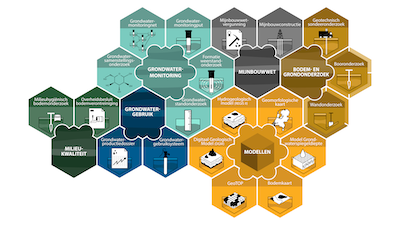Data types
Over the period 2018-2022, the first phase of the BRO register will be gradually put in place. Following each phase, the BRO will contain more information about both the deep and shallow subsurface environment. This information will be classified on the basis of data types, referred to as registration objects or RO’s. In total there will be around 24 registration objects.
Six domains
The registration objects are shared across six domains:
- Soil and subsurface investigation
- Groundwater monitoring
- Groundwater use
- Mining Act
- Site Quality
- Models and maps
1. Subsurface research
Registration objects:
- Cone penetration test (CPT)
- Borehole research (BHR)
- Borehole research-Pedology (BHR-P)
- Borehole research-Geotechnics (BHR-GT)
- Borehole research-Geology (BHR-G)
- Borehole research-Applied Geology (BHR-AG)
- Soil face research (SFR)
2. Groundwater monitoring
Registration objects:
- Groundwater monitoring well (GMW)
- Groundwater level dossier (GLD)
- Groundwater analysis report (GAR)
- Groundwater monitoring network (GMN)
- Formation resistance dossier (FRD)
3. Groundwater use
Registration objects:
- Groundwater utilisation facility (GUF)
- Groundwater production dossier (GPD)
4. Mining Act
Registration objects:
- Exploration production (and storage) licence (EPL)
- Exploration production construction (EPC)
5. Site Quality
Registration objects:
- Site Assessment Data (SAD)
- Soil Legal Decisions (SLD)
6. Models and maps
Registration objects:
- Soil and groundwater map (SGM)
- Geomorphological map (GMM)
- Hydrogeological model (HGM)
- Digital Geological Model (DGM)
- GeoTOP model (GTM)
- Water Table Depth Model (WDM)
Standardisation process
For each RO a data model is constructed. This is done in close cooperation with stakeholders and experts from the domain who understand the data itself as well as the business processes being used during the acquisition and processing of the data. During this standardisation process the data model is published on internet periodically for public review, making it fully transparent and giving every stakeholder the opportunity to provide feedback. In the end a formal document (catalogue) is produced describing the context of the RO and the semantic data model (entities, attributes, business rules) in detail.
Delen

Related
- Paper (pdf, 1.7 MB) 'Automated Data Exchange to and from the National Data Repository in the Netherlands' (TNO).
- Registration objects (BRO website, in Dutch)
- Planning (BRO website, in Dutch)